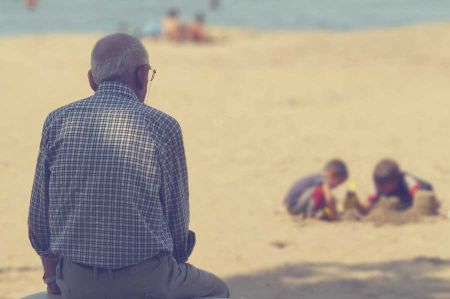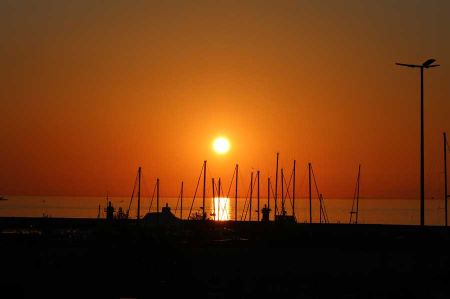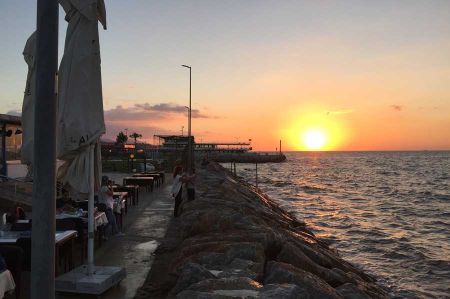Yalova on the Sea of Marmara - Istanbul by ferry
- Written by Portal Editor
We were coming from Bursa on the D 575 towards Yalova. Since we only want to go on a day trip to Istanbul this time, we decided to take the speedboat ferry across the Sea of Marmara to avoid having to drive the much longer way around the bay of Izmit.
Yalova is located directly across Istanbul on the south-eastern shore of the Marmara Sea, only 24 nautical miles from Istanbul.
Yalova is now a popular resort with a high level of local tourism. Many of the tourists come from Istanbul and the surrounding area and own a holiday home there. There are lot of vegetable and other gardens along the main road, the connecting road between İzmit and Bursa. Tourists from Arab countries also come to Yalova to spend their holidays there, mostly from Kuwait, the United Arab Emirates or Saudi Arabia.
 In the centre of the city there is a famous roundabout with a statue of Mustafa Kemal Ataturk in the middle. After the 1999 earthquake, many new buildings were built in the city. The Sahil beach promenade was expanded and embellished. A little to the west of the promenade, new parks were built on the rubble of the destroyed houses. Along the promenade there is a long sandy beach with couple of parks, children's playgrounds, tea gardens, ice cream parlours, restaurants and cafes. To the east of the port there is a large park with an amphitheatre. Events take place there in summer.
In the centre of the city there is a famous roundabout with a statue of Mustafa Kemal Ataturk in the middle. After the 1999 earthquake, many new buildings were built in the city. The Sahil beach promenade was expanded and embellished. A little to the west of the promenade, new parks were built on the rubble of the destroyed houses. Along the promenade there is a long sandy beach with couple of parks, children's playgrounds, tea gardens, ice cream parlours, restaurants and cafes. To the east of the port there is a large park with an amphitheatre. Events take place there in summer.
7 km southwest of the city is the Gökçe dam, which was built to supply drinking water.
Pylai - known in ancient times as a thermal bath
Called Pylai in ancient times, today Yalova is also the capital of the Turkish province of Yalova. In the past, the place Pylai was known far beyond the borders because of the thermal springs. The first Hellenistic settlers used the hot springs in a south-westerly direction, about 12 kilometres away, for bathing, which are also said to have healing properties. Constantine the Great and Emperor Justin I also made use of this possibility of healing, to name just a few important personalities. Known by the Romans under the name Pythia Therma, the Byzantines and after them the Ottomans continued the bathing culture. Even Kemal Ataturk used the thermal springs of Pythia and kept the building and the surrounding area prepared accordingly. His residence in Yalova (like the one in Florya) was converted into a museum as Ataturk's house. Unfortunately, there are only a few evidences from ancient times, and recordings are also rare.
The effects of the earthquake were felt for years
 When the devastating earthquake struck on August 17, 1999, which, under the name of the Marmara earthquake, is one of the great natural disasters in human history, Yalova was also badly affected. More than 16,000 people lost their lives, around 25,000 injured were admitted to hospitals and there are still countless people missing. At that time the earth shook for only 45 seconds, but the magnitude deflection on the Richter scale was 7.8.
When the devastating earthquake struck on August 17, 1999, which, under the name of the Marmara earthquake, is one of the great natural disasters in human history, Yalova was also badly affected. More than 16,000 people lost their lives, around 25,000 injured were admitted to hospitals and there are still countless people missing. At that time the earth shook for only 45 seconds, but the magnitude deflection on the Richter scale was 7.8.
After the great earthquake, the city of Yalova was rebuilt very quickly, green areas and parks were built on the huge amounts of rubble from the destroyed houses. The entire beach promenade with the long sandy beaches was redesigned and restored with children's playgrounds, tea gardens, ice cream parlours, restaurants and cafes.
City partnership with Bonn
In 1969, a town partnership with the then capital Bonn was launched, which is still maintained. Accordingly, you shouldn't be surprised if you come across a city park in Yalova that is called “Bad Godesberg Parkı”.
After a short excursion through the city, which leaves a tranquil impression in the city centre with the almost obligatory roundabout with the monument of Ataturk, we wentto the fast ferry to Istanbul.
Please also read:
Poznan or Poznan - another tour of the city
Onion Pie or Duck? - delicious food in Poznan
